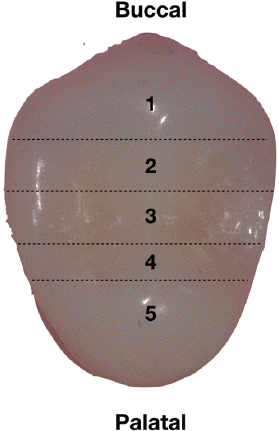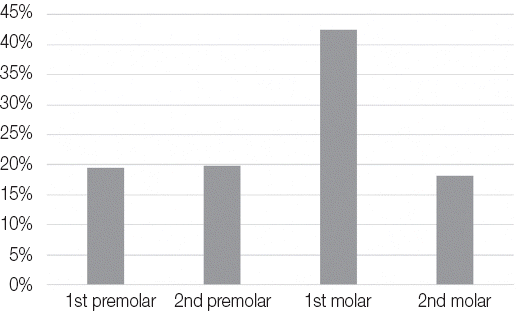1. Aw TC, Lepe X, Johnson GH, Mancl L. Characteristics of noncarious cervical lesions:a clinical investigation. J Am Dent Assoc. 2002; 133:725–33. DOI:
10.14219/jada.archive.2002.0268. PMID:
12083648.
2. Bader JD, McClure F, Scurria MS, Shugars DA, Heymann HO. Case-control study of non-carious cervical lesions. Community Dent Oral Epidemiol. 1996; 24:286–91. DOI:
10.1111/j.1600-0528.1996.tb00861.x. PMID:
8871039.
4. Smith WA, Marchan S, Rafeek RN. The prevalence and severity of non-carious cervical lesions in a group of patients attending a university hospital in Trinidad. J Oral Rehabil. 2008; 35:128–34. DOI:
10.1111/j.1365-2842.2007.01763.x. PMID:
18197846.
6. Nascimento MM, Gordan VV, Qvist V, Bader JD, Rindal DB, Williams OD, Gewartowski D, Fellows JL, Litaker MS, Gilbert GH. Dental Practice-Based Research Network Collaborative Group. Restoration of noncarious tooth defects by dentists in The Dental Practice-Based Research Network. J Am Dent Assoc. 2011; 142:1368–75. DOI:
10.14219/jada.archive.2011.0138. PMID:
22130438.
7. Ichim IP, Schmidlin PR, Li Q, Kieser JA, Swain MV. Restoration of non-carious cervical lesions:Part II. Restorative material selection to minimise fracture. Dent Mater. 2007; 23:1562–9. DOI:
10.1016/j.dental.2007.02.002. PMID:
17391747.
8. Grippo JO, Simring M, Coleman TA. Abfraction, abrasion, biocorrosion, and the enigma of noncarious cervical lesions:a 20-year perspective. J Esthet Restor Dent. 2012; 24:10–23. DOI:
10.1111/j.1708-8240.2011.00487.x. PMID:
22296690.
10. Estafan A, Furnari PC, Goldstein G, Hittelman EL. In vivo correlation of noncarious cervical lesions and occlusal wear. J Prosthet Dent. 2005; 93:221–6. DOI:
10.1016/j.prosdent.2004.12.012. PMID:
15775922.
11. Wood ID, Kassir AS, Brunton PA. Effect of lateral excursive movements on the progression of abfraction lesions. Oper Dent. 2009; 34:273–9. DOI:
10.2341/08-100. PMID:
19544815.
12. Goel VK, Khera SC, Ralston JL, Chang KH. Stresses at the dentinoenamel junction of human teeth-a finite element investigation. J Prosthet Dent. 1991; 66:451–9. DOI:
10.1016/0022-3913(91)90504-P. PMID:
1791555.
13. Chen KK, Miyake K, Terashita M. Cervical strains induced by occlusal loading. J Dent Res. 1999; 78:474.
14. Nohl FS, McCabe JF, Walls AWG. The effect of load angle on strains induced in maxillary premolars in vitro. J Dent Res. 1999; 78:1059.
15. Dejak B, Mlotkowski A, Romanowicz M. Finite element analysis of mechanism of cervical lesion formation in simulated molars during mastication and parafunction. J Prosthet Dent. 2005; 94:520–9. DOI:
10.1016/j.prosdent.2005.10.001. PMID:
16316798.
16. Lee HE, Lin CL, Wang CH, Cheng CH, Chang CH. Stresses at the cervical lesion of maxillary premolar-a finite element investigation. J Dent. 2002; 30:283–90. DOI:
10.1016/S0300-5712(02)00020-9. PMID:
12554108.
18. Pintado MR, DeLong R, Ko CC, Sakaguchi RL, Douglas WH. Correlation of noncarious cervical lesion size and occlusal wear in a single adult over a 14-year time span. J Prosthet Dent. 2000; 84:436–43. DOI:
10.1067/mpr.2000.109477. PMID:
11044852.
19. Rees JS, Hammadeh M, Jagger DC. Abfraction lesion formation in maxillary incisors, canines and premolars:a finite element study. Eur J Oral Sci. 2003; 111:149–54. DOI:
10.1034/j.1600-0722.2003.00018.x. PMID:
12648267.
20. Miller WD. Experiments and observations on the wasting of tooth tissue variously designated as erosion, abrasion, chemical abrasion, denudation, etc III. Dent Cosm. 1907; 49:225–47.
21. Radentz WH, Barnes GP, Cutright DE. A survey of factors possibly associated with cervical abrasion of tooth surfaces. J Periodontol. 1976; 47:148–54. DOI:
10.1902/jop.1976.47.3.148. PMID:
1062558.
22. Kullmer O, Benazzi S, Fiorenza L, Schulz D, Bacso S, Winzen O. Technical note:occlusal fingerprint analysis:quantification of tooth wear pattern. Am J Phys Anthropol. 2009; 139:600–5. DOI:
10.1002/ajpa.21086. PMID:
19425091.
23. Brandini DA, Trevisan CL, Panzarini SR, Pedrini D. Clinical evaluation of the association between noncarious cervical lesions and occlusal forces. J Prosthet Dent. 2012; 108:298–303. DOI:
10.1016/S0022-3913(12)60180-2. PMID:
23107237.
24. Sawlani K, Lawson NC, Burgess JO, Lemons JE, Kinderknecht KE, Givan DA, Ramp L. Factors influencing the progression of noncarious cervical lesions:A 5-year prospective clinical evaluation. J Prosthet Dent. 2016; 115:571–7. DOI:
10.1016/j.prosdent.2015.10.021. PMID:
26774320.
25. Benazzi S, Kullmer O, Grosse IR, Weber GW. Using occlusal wear information and finite element analysis to investigate stress distributions in human molars. J Anat. 2011; 219:259–72. DOI:
10.1111/j.1469-7580.2011.01396.x. PMID:
21615398. PMCID:
PMC3171771.
26. Harvey WL, Hatch RA, Osborne JW. Computerized occlusal analysis:an evaluation of the sensors. J Prosthet Dent. 1991; 65:89–92. DOI:
10.1016/0022-3913(91)90056-3. PMID:
2033554.




 PDF
PDF Citation
Citation Print
Print




 XML Download
XML Download